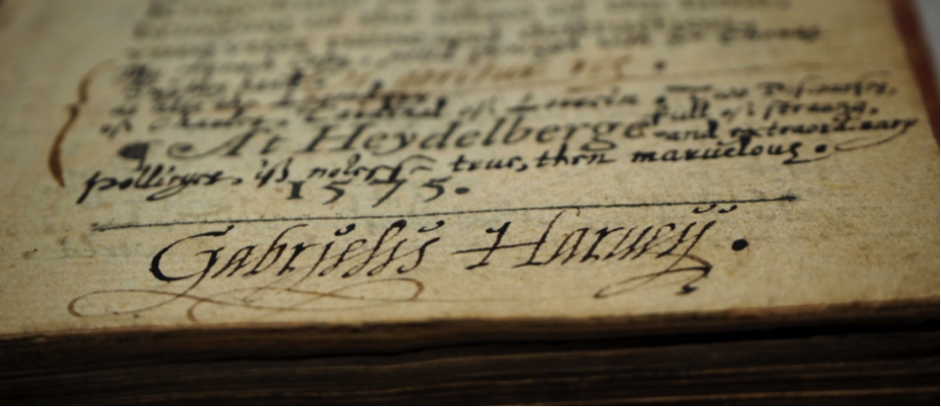I’ve just written a report for the Cambridge Digital Library about a book that is about to go live on their website. It’s a new acquisition for the UL, with generous assistance from the Friends of the National Libraries, and a tiny but very exciting purchase. Copying it here for those who can’t wait.

“Adv.e.8.1 is a copy of A Mervaylous Discourse Upon the Lyfe, Deedes, and Behaviours of Katherine de Medicis, Queene Mother, a translation of an anonymous European bestseller which was published in London in 1575 with a false imprint (‘At Heydelberge’). It is a diminutive octavo volume with a text block measuring 129 x 89 mms and it has been harshly trimmed, probably when it acquired its current mid-nineteenth century binding. Nonetheless, that trimming failed to excise the evidence of an extraordinarily intensive reading of the volume by the Cambridge scholar and bibliophile Gabriel Harvey (1552/3–1631). This hitherto unrecorded book from his collection offers a unique record of an English analysis of recent French history and extends our knowledge of one of the most conspicuous and fascinating early modern annotators.
Issued soon after the death of Charles IX in 1574, the Discours merveilleux de la vie, actions et deportmens de Catherine de Medicis, roine mere (1575) attracted substantial attention across Europe. The Universal Short-Title Catalogue currently identifies seven French editions before 1580, along with early translations into Dutch, German, Latin and English. The text offers a blow-by-blow account of ‘the pernicious and wicked practices of the Queene’, emphasising her ruthlessness, her willingness to exploit religious divisions to increase her power, and the threat that her machinations pose to the realm of France.
The different shades of ink in the annotations may point to two or more readings, which were probably undertaken during Harvey’s time as a Fellow of Pembroke College, Cambridge; a note on the final leaf is dated 1578. Harvey’s attention is throughout closely focused on the political principles that can be drawn out of Katherine’s life story. The indexed notes on the verso of the title-page offer a preliminary guide to the nature of his interests. He saw Catherine as an embodiment of amoral modernity, embodying precepts from ‘Machiavels pragmatical Politiques’, and ‘Aretinos licentious Ethiques’, all of which were put in the shade by ‘Her own private, and publique Experience in all ambitious, covetous, and voluptuous Practises of the world’. She was ‘In manner, thonly Curtisan Politique of France, In respect of whome, Bodin [is] but A schollar, & theorist’ (a note on H4v seems to refer to a meeting between Harvey and the political philosopher Jean Bodin). Harvey frequently proclaimed the superiority of action to contemplation, and he displays a kind of horrified admiration for Catherine’s unceasing villainy: ‘Evermore in actu: in esse: unhorsing other, & setling herself in the saddle: never owt of worke, at home, abrode; private, publique, of al sorts: fram’d to do, & undoo all thinges, at her pleasure, and for her advantage. In manner, th’only Polypragmatical of the world’.
The copious marginal notes that follow are also darkly appreciative, relishing ‘Italian Practises’ (I3r) and acts of ‘deepe, & profounde dissimulation’ (F7r) and labelling the 1572 St Bartholomew’s Day massacre of Protestants a ‘Comicotragoedia’ or tragicomedy (G4r). Harvey also deploys his standard (but often mysterious) array of marginal symbols, including astrological symbols (e.g. Mars for war) and ‘J.C.’ (‘jurisconsultus’) for legal affairs. There are several glances at English politics, as when a discussion of whether a dying king as a right to appoint his successor leads Harvey to recall how ‘King Edward VI. ordeinid by will, the Lady Jane Grey; excluding his two sisters’ (L1r). The Comte de Retz, meanwhile, is ‘the Lord [Thomas] Cromwell in another kind’ (M3v). Harvey’s determination to be up-to-date is indicated by his use, on several occasions, of the word ‘assassination’ (E6v, E7r), a word which is not elsewhere attested before 1590.
Harvey notes on the title page that he also owns a French edition of the Discourse with the annotations of his patron Sir Thomas Smith; this book is currently unlocated.Virginia F. Stern’s 1979 study Gabriel Harvey: His Life, Marginalia and Library counts 155 works known to have belonged to him, not all of which are extant. One of the those books, an edition of Livy now in the Princeton University Library, formed the basis for a seminal article by Anthony Grafton and Lisa Jardine, ‘“Studied for Action”: How Gabriel Harvey Reed his Livy’ (1990), which showed that early modern reading was often communal and political rather than solitary and private. In the wake of this intervention, many more scholars have examined the nature of Harvey’s reading, and 14 of his books have now been published in digital facsimiles, with full transcriptions, on the ‘Digital Bookwheel’ of the Archaeology of Reading project (https://archaeologyofreading.org/). The present volume offers a fascinating addition to the corpus and an opportunity to extend our conversations about what reading has meant in the past, and what it means today.”